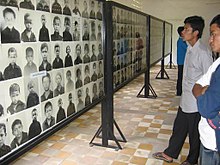Khmer Rouge regime
Main articles: Democratic Kampuchea and Khmer Rouge
The Khmer Rouge reached Phnom Penh and took power in 1975. Led by Pol Pot, they changed the official name of the country to Democratic Kampuchea. The new regime modelled itself on Maoist China during the Great Leap Forward, immediately evacuated the cities, and sent the entire population on forced marches to rural work projects. They attempted to rebuild the country's agriculture on the model of the 11th century, discarded Western medicine and destroyed temples, libraries, and anything considered Western.
Estimates as to how many people were killed by the Khmer Rouge regime range from approximately one to three million; the most commonly cited figure is two million (about a quarter of the population).[57][58][59] This era gave rise to the term Killing Fields, and the prison Tuol Sleng became notorious for its history of mass killing. Hundreds of thousands fled across the border into neighbouring Thailand. The regime disproportionately targeted ethnic minority groups. The Cham Muslims suffered serious purges with as much as half of their population exterminated.[60] Pol Pot was determined to keep his power and disenfranchise any enemies or potential threats, and thus increased his violent and aggressive actions against his people.[61]
Forced repatriation in 1970 and deaths during the Khmer Rouge era reduced the Vietnamese population in Cambodia from between 250,000 and 300,000 in 1969 to a reported 56,000 in 1984.[46] However, most of the victims of the Khmer Rouge regime were not ethnic minorities but ethnic Khmer. Professionals, such as doctors, lawyers and teachers, were also targeted. According to Robert D. Kaplan, "eyeglasses were as deadly as the yellow star" as they were seen as a sign of intellectualism.[62]
Vietnamese occupation and transition
Main articles: People's Republic of Kampuchea and Cambodian–Vietnamese War
In November 1978, Vietnamese troops invaded Cambodia in response to border raids by the Khmer Rouge.[63] The People's Republic of Kampuchea (PRK), a pro-Soviet state led by the Kampuchean People's Revolutionary Party, a party created by the Vietnamese in 1951, and led by a group of Khmer Rouge who had fled Cambodia to avoid being purged by Pol Pot and Ta Mok, was established.[clarification needed][64] It was fully beholden to the occupying Vietnamese army and under direction of the Vietnamese ambassador to Phnom Penh. Its arms came from Vietnam and the Soviet Union.[65]
In opposition to the newly created state, a government-in-exile referred to as the Coalition Government of Democratic Kampuchea (CGDK) was formed in 1981 from three factions.[65] This consisted of the Khmer Rouge, a royalist faction led by Sihanouk, and the Khmer People's National Liberation Front. Its credentials were recognised by the United Nations. The Khmer Rouge representative to the UN, Thiounn Prasith, was retained, but he had to work in consultation with representatives of the noncommunist Cambodian parties.[66][67] The refusal of Vietnam to withdraw from Cambodia led to economic sanctions[68] by the US and its allies.[specify]
Peace efforts began in Paris in 1989 under the State of Cambodia, culminating two years later in October 1991 in a Paris Comprehensive Peace Settlement. The UN was given a mandate to enforce a ceasefire and deal with refugees and disarmament known as the United Nations Transitional Authority in Cambodia (UNTAC)




0 comments:
Post a Comment